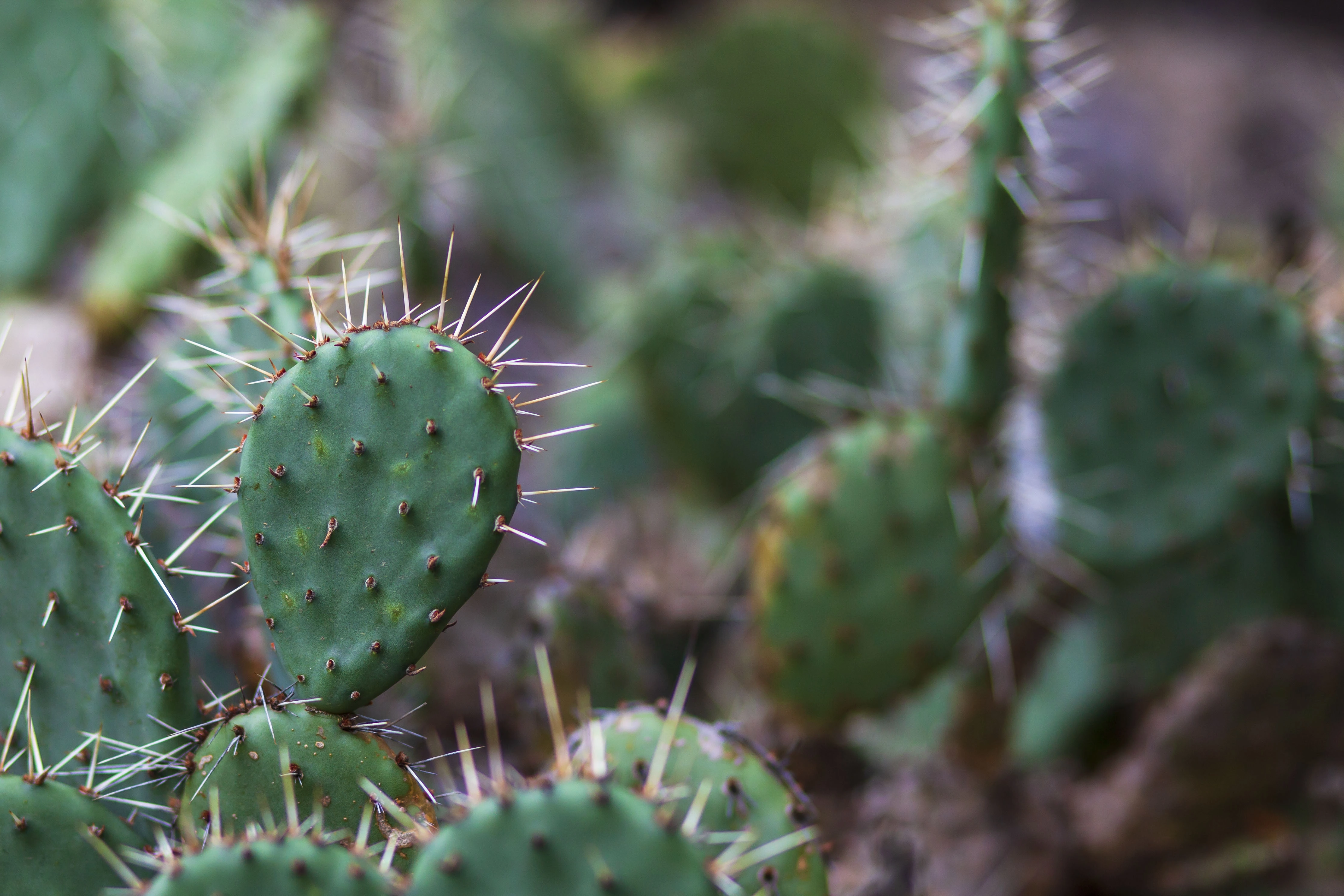Opuntia Microdasys commonly known as bunny ear cactus is easy to grow 3 feet tall cactus for novice gardeners. It has its origin in Mexico where it mainly grows in the arid regions with a spread of almost 5 feet.
Bunny ear cactus is called so because of its paired thick long pads decorated with brown circular fizzy glochids which give off an appearance of the furry bunny ears.
OpuntiaMicrodasys requires physical conditions similar to its native geographical conditions for its perfect and healthy growth.
Thus, it requires a place having bright light and low humidity for good growth and if your place’s physical condition suits it then this cactus will be the perfect plant for you.
This cactus is an excellent houseplant and if kept properly then during summers, we might welcome the blossoming of large creamy yellowish flowers followed by the formation of purplish globular fruits.
Identification
OpuntiaMicrodasys is a 2-3 feet tall cactus that has a native spread of about 5 feet.
As a houseplant bunny ear cactus becomes a slow-growing cactus because of the unavailability of the exact proper native physical conditions.
Hence, the plant grows in height and width up to 2 feet only.
The Bunny ear cactus flower is quite a beauty because of its creamy yellowish appearance. Even the fruits formed increases the aesthetic with their purplish globular look.
Caring for the succulent
Opuntia Microdasys being a cactus is a low maintenance plant. Bunny ear cactus care routine involves less watering and more sunlight.
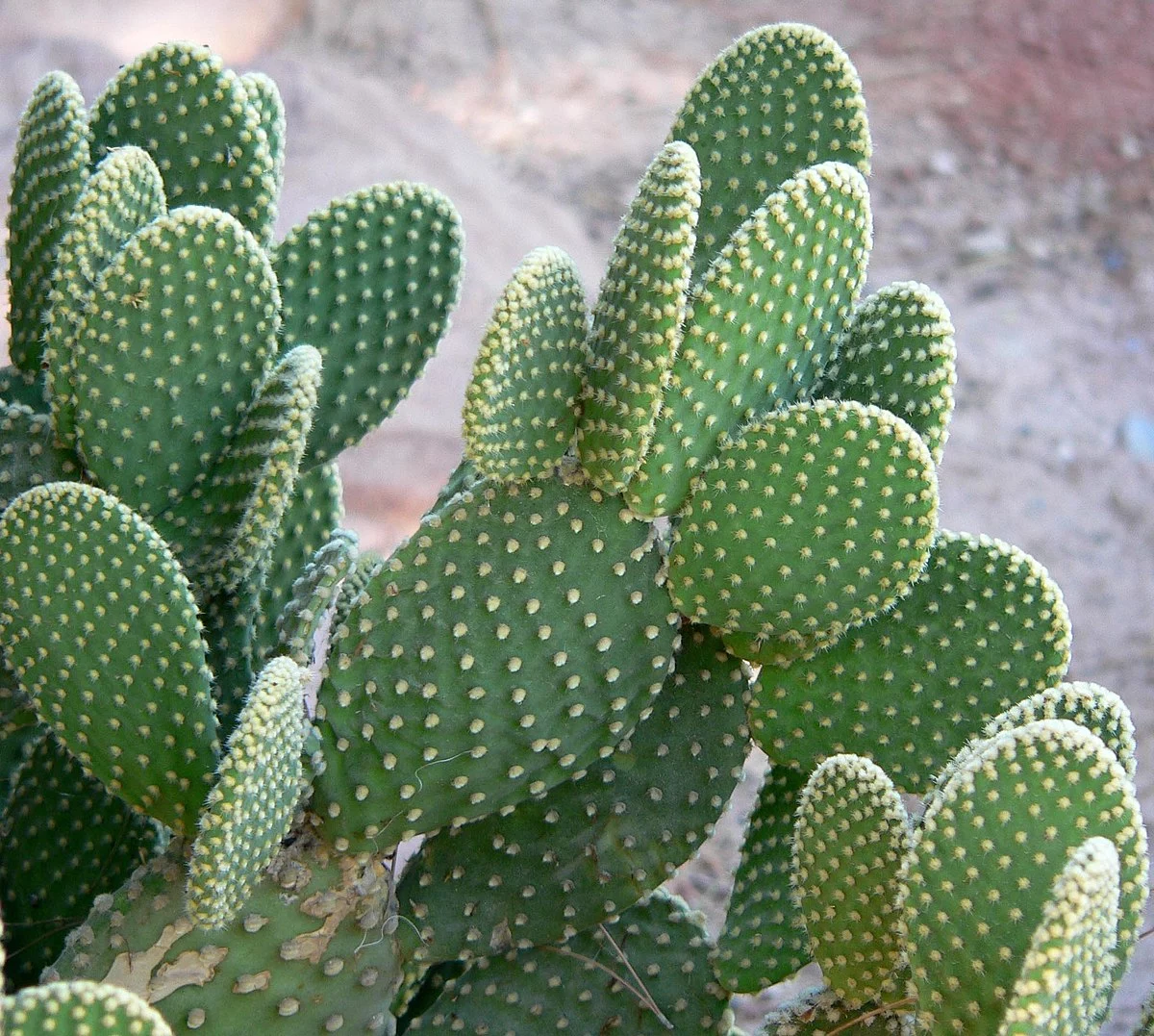
Temperature and humidity
The cactus requires an ideal temperature ranging from 60-100oF. For winters and fall, the temperature requirement becomes relatively cooler.
Low humid conditions are ideal for its growth. If the place lacks low humidity then great care needs to be taken with the watering schedule.
Sunlight
Bright sunlight is needed for the healthy growth of the Opuntia Microdasys because of it being an arid region succulent.
Humidity
The shrub grows perfectly when there is low humidity. If your place lacks low humidity then you have to make sure you water the shrub rarely to compensate for it.
Soil requirements and fertilizing
To grow the cactus properly, the soil needs to be proper. We can either buy a cactus soil mix or prepare a mix with a 1:1:1 ratio of coarse sand, perlite, and cactus mix.
The Bunny ear cactus is to be fertilized using a cactus fertilizing formula during springs and summers.
Watering
Water the succulents only when the soil of the pot gets extremely dry. After watering has been done, proper drainage of the water is needed and any leftover water remaining in the saucer should also be thrown away. During rainy seasons, the watering frequency should reduce to once a month.
Tips to proper watering
Bunny ear cactus watering is a huge task. The watering routine entirely depends upon the seasons and the soil dryness.
If we end up watering more than required then we encounter rotting of bunny ear cactus.
Moreover, Bunny ear cactus drooping is caused by a lack of adequate supply of water.
So, how to water bunny ear cactus?
Firstly, we need to check the seasons. During summers, drying up of the soil will be faster as a result once a week watering is needed. Any delay in the watering can result in the drying of the plant.
During winters and autumns, the soil will not dry up fast as a result once a month watering is enough.
For spring, the watering schedule is similar to that required for summer.
Secondly, we need to check whether the soil is bone-dry or not. Blindly following the watering schedule can result in the plant getting watered even when the soil did not lose all of its moisture.
How often to water bunny ear cactus?
Watering schedules as per the seasons should be followed along with the soil dryness check.
Do not worry; if you are not good with schedules then you shall regularly check the soil dryness. You can check the dryness with the help of a towel or a wooden dowel. And if you want to avoid manual methods then you can also use a hygrometer.
Propagation of the succulent
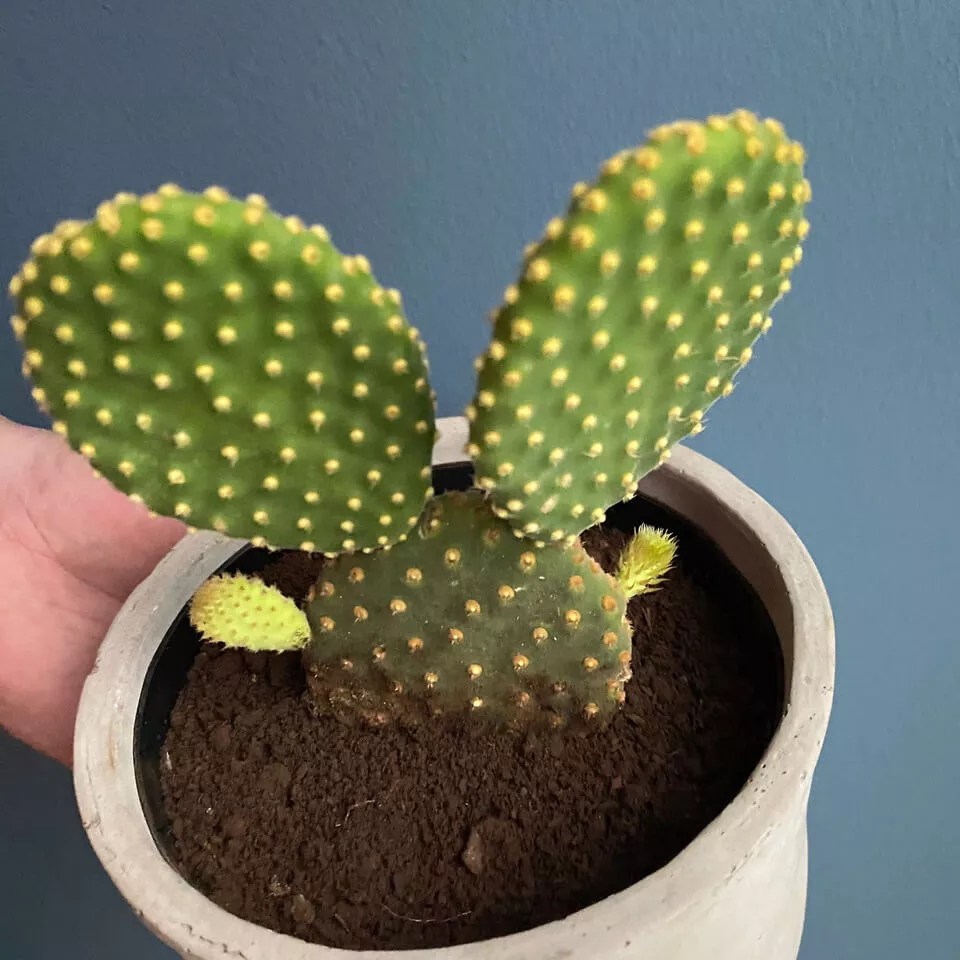
You bought Opuntia Microdasys and now you are wondering how to start a new bunny ear cactus?
Or, you are wondering how to propagate bunny ear cactus?
Then the following steps will guide you with this. But, before that, do not be fooled by the harmless look of the brown glochid prickles present on the bunny pads.
The succulent has these prickles as a self-defense mechanism which is easily dislodged by wind and slight contact thereby irritating skin.
Now since you have been warned. Therefore, let us continue with the bunny ear cactus propagation steps.
Steps:
- Cut 3 to 4 bunny earpads from the mature succulent with the help of tweezers as a backup for the drying of the pads.
- Leave the cut-out pads to callus for a few days. We can dip the cuttings in root hormones to speed up root growth.
- In the meantime, prepare the soil mixture. We can use a readymade potting mixture or we can use the self-made soil mix.
- Now put the soil mixture in a clay pot. Make sure that the pot to be used is quite large as compared to the previous pot.
- Now once the cuts have been callused we will plant them one inch deep into the pot. Place the pot in bright sunlight. No watering is needed since the soil mixture will be quite moist.
- After a few days bunny ear cactus rooting will start. Now after this, we need to have a regular watering schedule for at least a year.
Another well-known method that is widely used to propagate this cactus using water Read more
What is the size of a mature Opuntia Microdasys?
A mature bunny ear cactus will grow up to a height of 3-4 feet with a spread of about 5 feet when in its native geographical place or when grown as an outdoor shrub in dessert gardens or rocky gardens.
But, if it is grown as an indoor plant, then the growth rate shall be slow and the shrub will attain a height of 2 feet with a spread of similar kind.
Is your bunny ear cactus growing long despite being a houseplant?
Blooming of the succulent
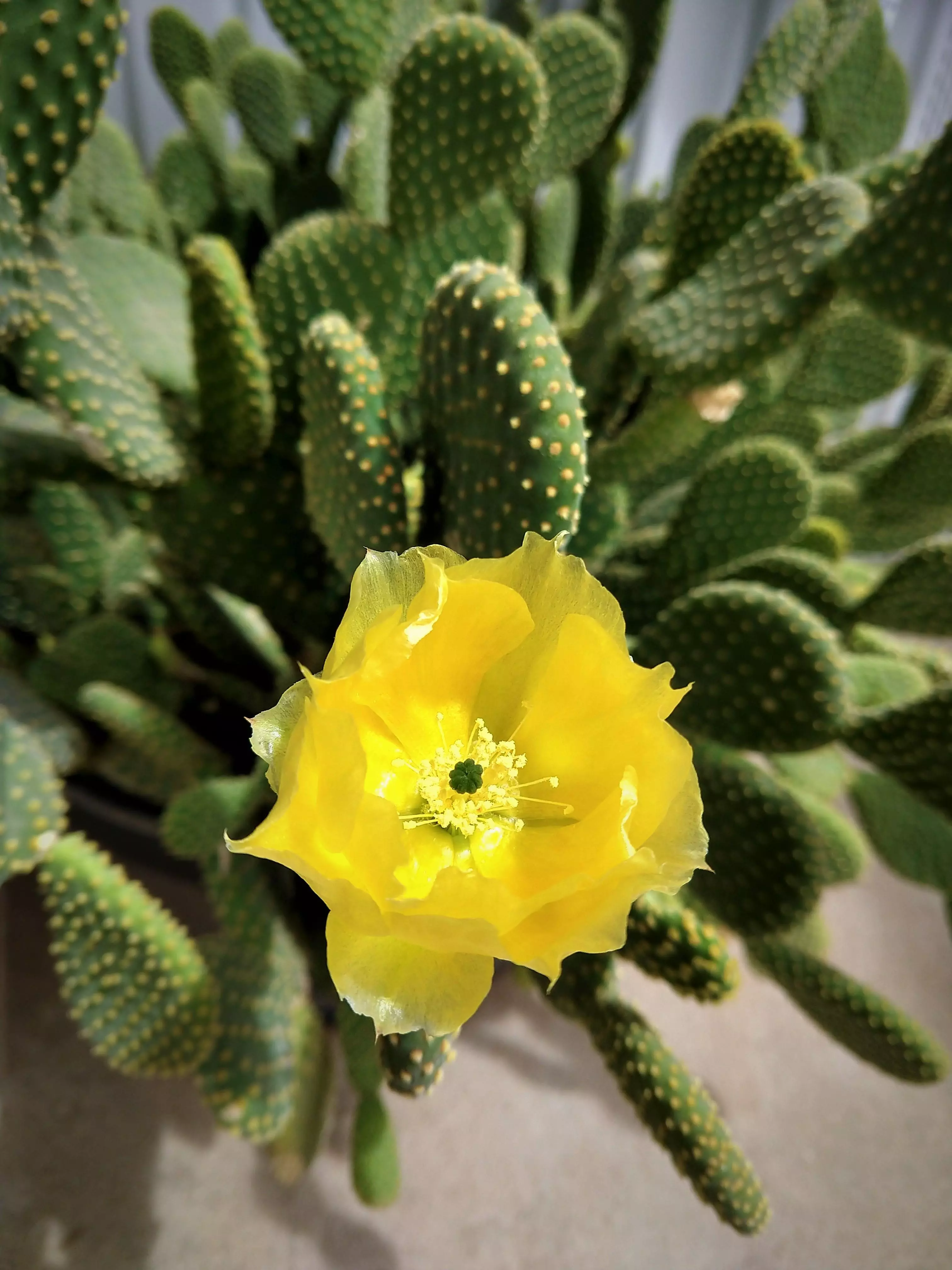
Bunny ear cactus generally blossom during summer. But it might even blossom during spring.
The blossoming of Opuntia Microdasys is confirmed when the physical conditions of the place or the artificial physical condition provided by the owner are similar to its native conditions.
Mostly, these succulents are in demand because of the increase in their aesthetic value after it flowers and fruits.
The flowers with their yellowish creamy appearance will be a pleasurable sight. And the purplish round fruits just heighten the aesthetic look of the houseplant.
Then it is so, because either the clay pot size is quite large which gives the shrub enough space to spread, or the dose of the growth hormones played well.
Potting and re-potting schedule

How often shall we re-pot?
Opuntia Microdasys requires to be re-potted within 1.5-2 years.
Make sure that you re-pot the plant in a relatively larger clay pot as compared to the size of the current clay pot.
After re-potting, it is advisable to put the clay pot in direct sunlight. If you lack, bright sunlight then you can also make arrangements for artificial lighting.
Watering of the bunny ear cactus should be avoided for at least a week or two. Fertilizing the plant should be avoided for about a month if we re-pot the shrub during spring or summer.
Diseases & solutions
Let us now discuss some of the common diseases observed and the solutions.
Drooping
Is your shrub drooping lately?
And you are curious about what could go wrong with the care?
Well, it might have happened that lately, you are not taking adequate care of the plant.
Drooping of the shrub occurs when the water supply and the sunlight supply is not adequate.
How to restore its health?
Water it according to the recommended watering schedules and provide adequate sunlight. Never miss a single watering day. But yes, in the process do not end up overwatering the shrub. Always check for soil dryness.
And if you diligently follow the watering schedule then you might restore your Opuntia Microdasys to health.
Rotting and turning light green or white
Excessive watering of the cactus is harmful to it. The shrub will end up rotting because of it.
Now, is your place lately not providing enough sunlight?
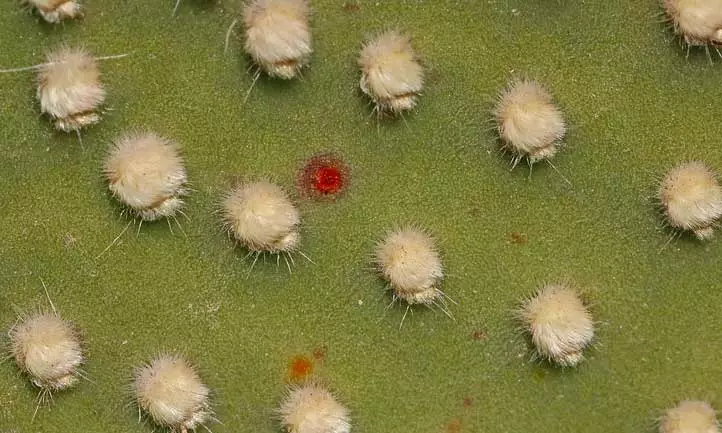
If it is so, then be sure that your bunny ear cactus turning light green, rotting and drooping is all because of lack of adequate sunlight.
The shrub turning complete white indicates the extreme case of lack of sunlight.
Now, what is the solution?
Well, if you have overwatered your shrub then the only way to restore it is to avoid watering it for at least a week. Make sure to provide it with adequate sunlight but not direct sunlight. After the plant and the roots are dry then re-pot it in a clay pot with a good drainage system.
And if your plant is dying because of lack of adequate sunlight, then better shift the pot to a place with an adequate supply of sunlight or make arrangements for good artificial lighting.
White patches
Bunny ear cactus white patches are a sign of pest attack.
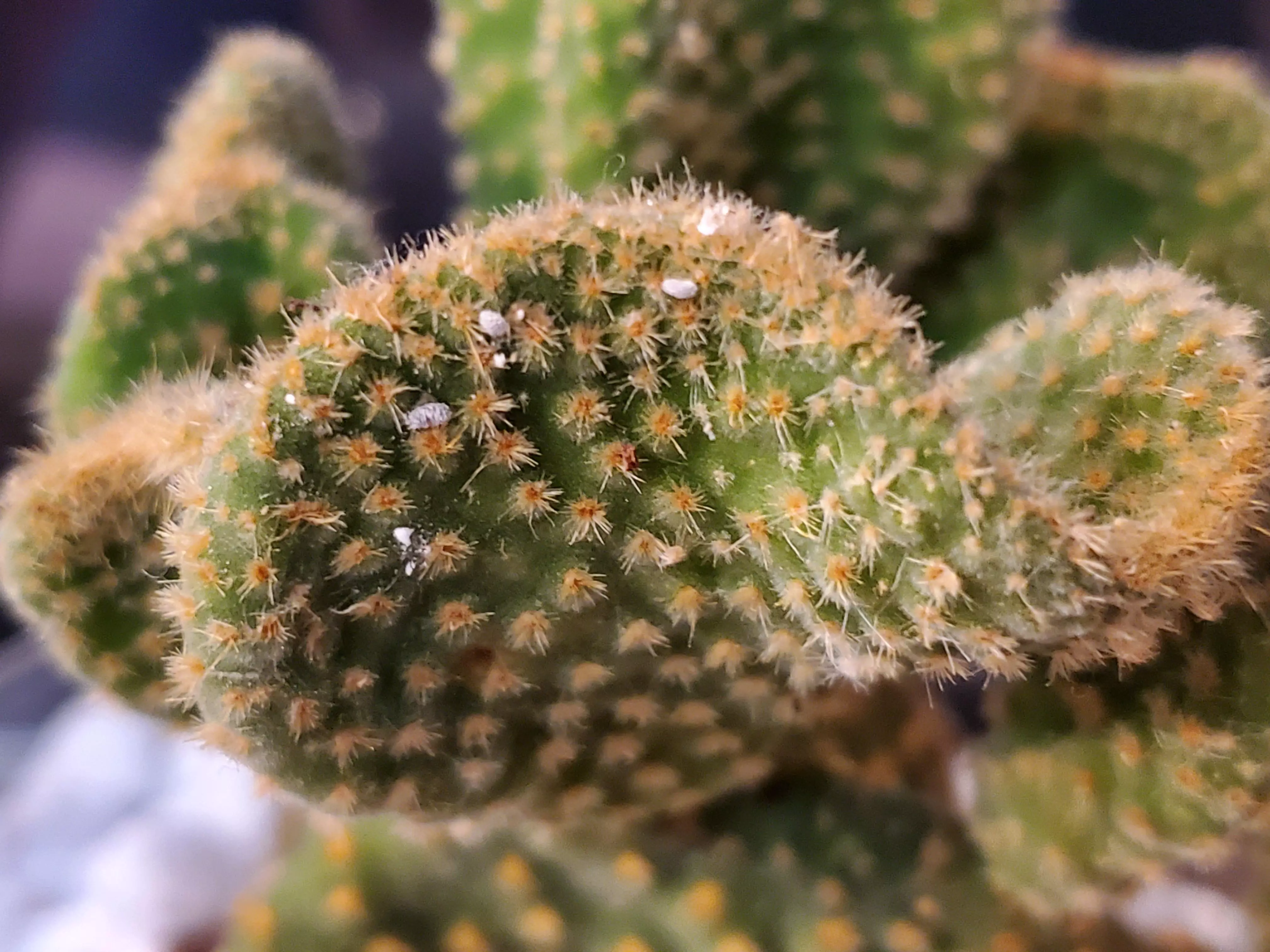
The pest attack on the bunny ear cactus is mainly done by the mealybugs. And in severe cases, the succulent will turn brown eventually resulting in death.
To save the cactus, we need to apply to dilute isopropyl alcohol on the plant with the help of cotton pads. This might save your plant only during the initial stages. Once, the plant has turned brown then restoring it will be difficult.
Toxicity toward pets and children
The shrub’s flowers and fruits are non-toxic to pets and children. But we should be careful about the brownish glochids since they cause skin irritation and hence the kids and the pets should be kept away from it.
A solution to skin irritation is the use of cool water and soap on the skin.
Find 10 other cacti and succulents that are toxic to pets and children here.
Purchase
As stated earlier, bunny ear cactus is a good investment for novice gardeners. It is also a suitable purchase to be made by those who have a tight schedule since these shrubs are low-maintenance plants.
This cactus has a great aesthetic value because of its bunny ear pads ornamented with brownish glochids, creamy flowers, and purplish fruits.
The purchase can be made over online boutiques. And it is quite safe to make a purchase online during this pandemic.
If you want a variety, then purchasing cinnamon bunny ear cactus will be a great choice.
Summary
Opuntia Microdasys is another great succulent to be grown as a houseplant or an outdoor plant.
In this busy world, succulent purchases are increasing rapidly because of their low maintenance.
The aesthetic value of these shrubs is also impressive and hence is also to be used as decorative items.
The bunny ear pads decorated with brown glochids give off a fuzzy appearance which makes the plant look unique in an aesthetically pleasing way. The flowers and the fruits are like the cherry on the top.
Although these shrubs are of low maintenance, still we need to follow a strict watering schedule to avoid overwatering and under-watering. An adequate supply of sunlight is required for the shrub to grow up to its fullest potential.
The pots used should be made of clay and should have some pores in them to provide a good water drainage system.
Always, use a pot which quite large since this will provide some space for the root spreading.
The plant can be fertilized once a month. But it is recommended to mainly fertilize it during springs or summers.
Although it is a slow-growing shrub the process of taking care of it till it grows to become a mature plant is quite thrilling.
Thus lastly, the shrub is a valuable purchase to be made. I hope that you had fun, informative, and helpful reading about the bunny ear cactus.
Happy planting now!
